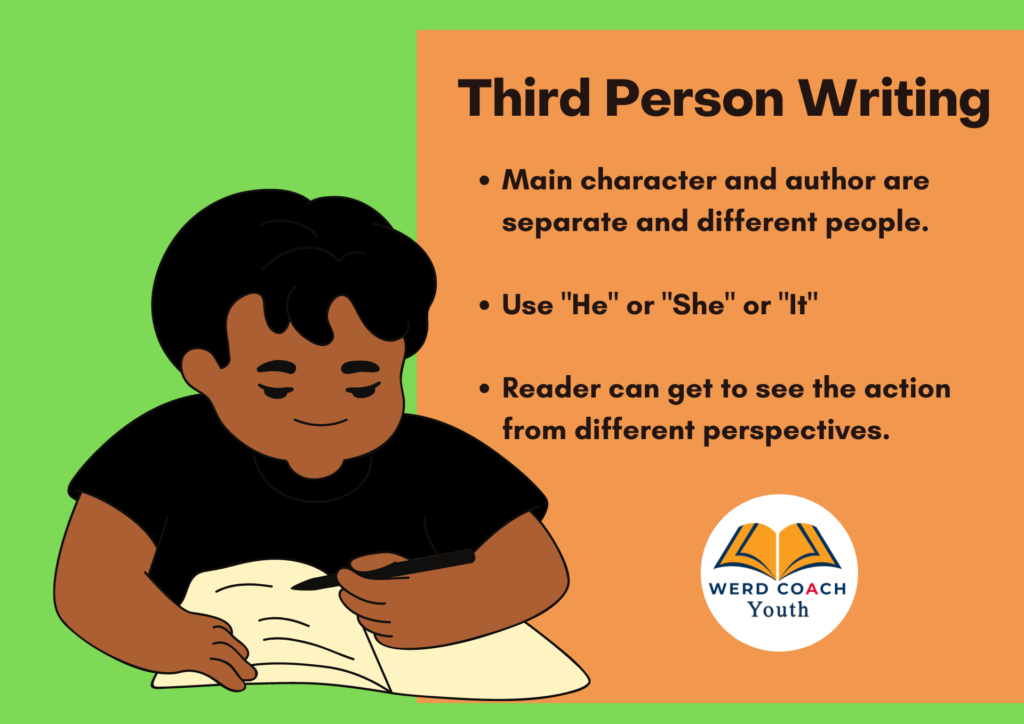Young writers preparing for SEA usually work with the first person perspective. They are asked to put themselves in the position of the main character. However, that’s not the only way prompts are written. In fact, for 2020, two of the three SEA narrative prompts were third person. It’s a good idea to get your young writer familiar with both styles of writing so they will be comfortable regardless of which type of prompt comes their way. When writers use the first person perspective in writing, the author of the story is the main character. The author can use “I” and “we” and “my” freely because the story is written from the author’s point of view.
Here are three tips to keep in mind when writing first person narratives.
1. Understand the perspective. The key aspect of first person is that the audience gets to see events through the eyes of someone who is directly experiencing the highs and lows. That means the audience gets a front seat view of thoughts and ideas.
Because of that, an immediate emotional connection happens as audiences feel like it’s a friend they know who is telling them the story.
2. Use the perspective to your advantage. When the first person draws the reader into the situation, readers can be easily misled to create wonderful suspense and mystery. That’s because first person perspectives give only a limited view of the action, only from the main character’s perspective.
What the main character doesn’t see or hear or experience is not told to the reader.
3. Beware of the overused “I”. When writers participate in their own stories, it’s often a challenge to avoid beginning sentences with the word “I”. Because everything is told with the writer involved, the word “I” can overwhelm readers.
To work around that, young writers can focus on what is observed as the action takes place. Readers already know who is observing the situation, so that bit can be left out. Doing that requires crafty use of vivid imagery, which audiences will love. Here’s an example.
ORIGINAL: I heard the trickling of water and it gave me the chills.
REVISED: The trickling of water echoed down the corridor, giving me the chills.

When writers use the third person perspective in writing, the author is not the main character. In fact, the author isn’t a character anywhere in the story. Instead, the author uses “He”, “She” and “It” to talk about characters.
Below are three tips to keep in mind when writing third person narratives.
1. Understand the perspective. The key aspect of third person is that the audience gets a more complete view of the action. That means readers learn about what’s happening from the narrator, not directly from a character in the story.
Writers can move from one character to another, giving details and reactions more freely than with first person. Just be careful not to hop from character to character too often. The story should still be told from one main perspective – the main character’s.
2. Use the perspective to your advantage. Because the writer and the main character are separate people, the writer can freely observe the main character. Character descriptions are much easier to present in third person writing.
Take the opportunity to give each character a distinct voice and unique characteristics so that readers can come to their own opinions.
3. Beware of internal thoughts. Unlike first person, third person makes it challenging to include the main character’s thoughts. How characters feel and react to situations should be demonstrated through what they do and say.
While writers can say things like, “Elizabeth thought…” it’s much more engaging to write about what Elizabeth did and said so that readers can determine for themselves what might have caused her to behave that way. This is one way to keep the mystery and suspense in third person writing.
ORIGINAL – Elizabeth thought Andy was crazy. That was definitely another one of his mad scientist ideas.
REVISED – “Are you crazy?” Elizabeth squinted at Andy, slowly nodding her head from side to side. That was definitely another one of his mad scientist ideas.

